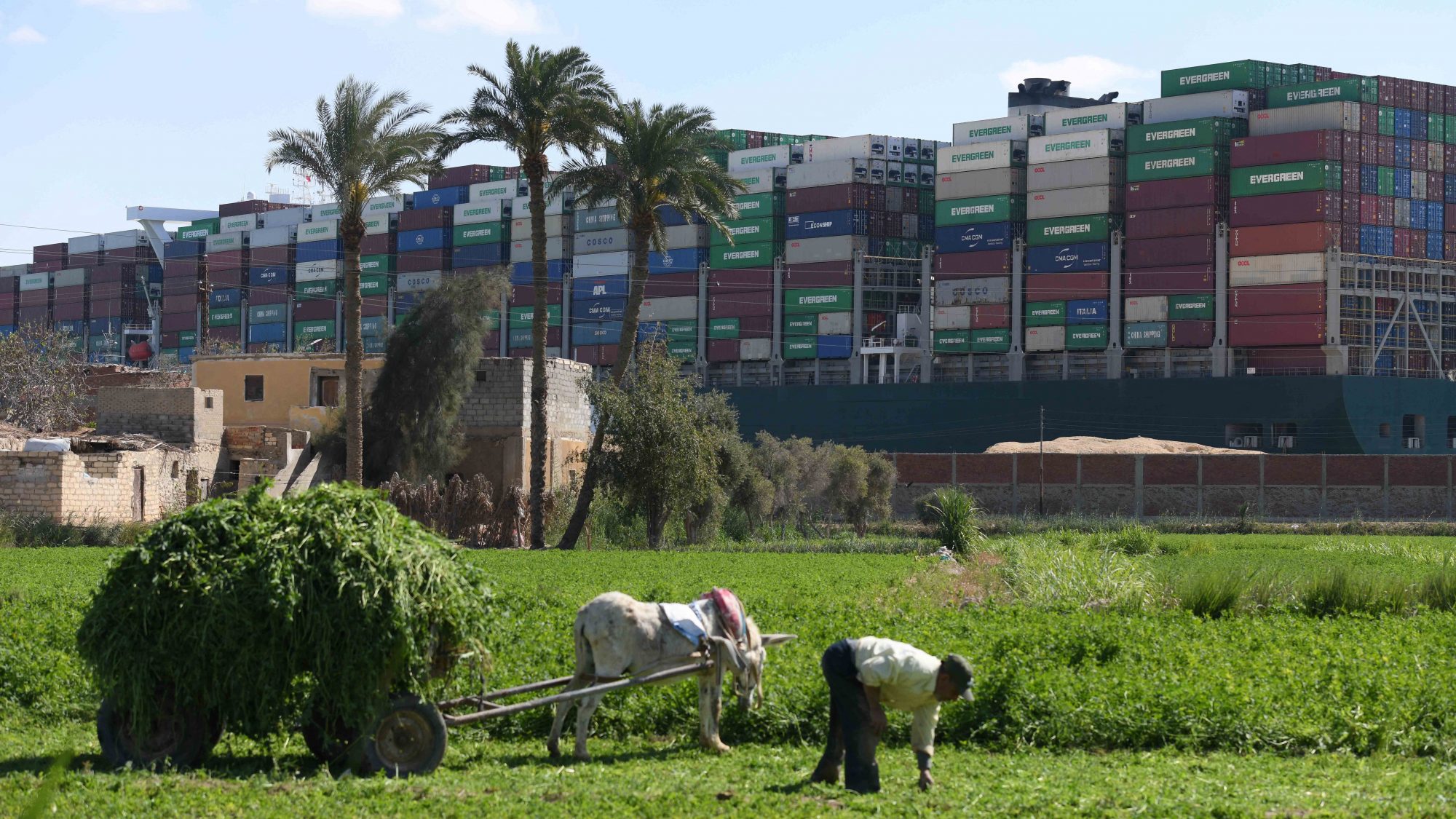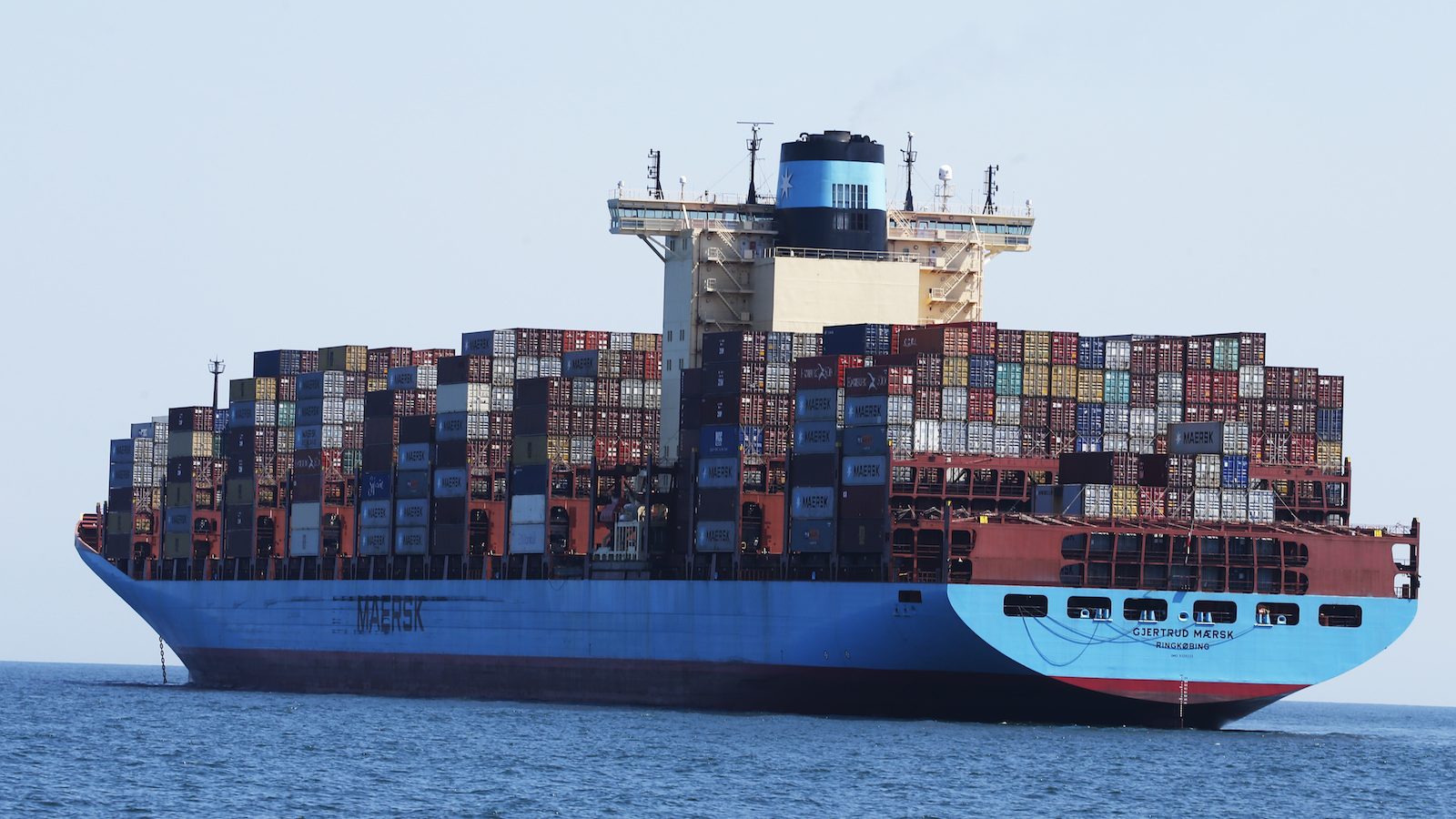Ever Given, the cargo ship that’s been wedged in the Suez Canal since Tuesday, is a behemoth, stretching as long as the Empire State Building stands tall. It belongs to a growing fleet of “mega ships,” which can carry two or three times more cargo than the average new container vessel. At its fullest, Ever Given can hold more than 20,000 twenty-foot containers on its deck, making it one of the world’s biggest container ships.
The waylaid Ever Given was sailing through the Suez Canal on its way from China to the Netherlands when it ran aground during a dust storm. The 120-mile-long canal connects the Red Sea to the Mediterranean, providing ships a shortcut between Europe and Asia and allowing them to avoid sailing around the southern tip of Africa. About 10 percent of all global trade flows through this crucial maritime artery.
Ever Given’s heft is complicating efforts to dislodge it. Meanwhile, the 1,300-foot-long vessel is blocking the flow of billions of dollars’ worth of goods, including everyday essentials like toilet paper and coffee.
Interestingly, the ship’s titanic size is supposed to make it more environmentally friendly. Vessels like it are a move toward satisfying the shipping industry’s broader goals to improve energy efficiency and curb carbon dioxide emissions. The International Maritime Organization, part of the United Nations, aims to reduce total shipping emissions by at least 50 percent from 2008 levels by 2050, and to completely decarbonize ships by the end of this century.
Shipping companies claim that piling more boxes on a single ship reduces the amount of fuel burned, and thus greenhouse gas emissions created, for every unit of goods hauled across the water. Mega ships are also built to operate at slower speeds, minimizing the amount of fuel the engines use while in transit — and reducing the risk of ships colliding with whales. The Danish shipping giant A.P. Moller-Maersk has said its own massive vessels could cut per-container emissions by 50 percent compared to the industry average.
So it’s no surprise Maersk counts at least 30 of its “Triple E” mega ships in its fleet. Evergreen Marine Corp., the Taiwanese firm that operates Ever Given, has ordered 10 new vessels that will be able to carry even more than 20,000 containers. And last year, South Korea’s Hyundai Merchant Marine launched a dozen of its “highly efficient” vessels, each of which can move a staggering 24,000 containers.
Of course, a mega ship that forces hundreds of others to idle indefinitely — or take a much longer route around Africa — is no boon at all to the efficiency of the greater shipping industry. Shipping analysts have told news outlets it may take days or weeks to remove the 224,000-ton Ever Given from the storied canal. In the meantime, the debacle is bringing attention to a multitrillion-dollar industry that normally slips under the public’s radar.
Cargo ships are a significant source of global greenhouse gas emissions — nearly 3 percent annually — but for many people they remain out of sight and out of mind, said Aoife O’Leary, the London-based director of international climate for the Environmental Defense Fund. “It takes a big disaster for the shipping industry to come into the public eye,” she said, adding that she worries that the lack of attention on the industry during normal times means it face less public pressure to reduce overall emissions.
That might help explain why industry regulators are moving slowly to clean up cargo ships, nearly all of which run on fossil fuels. The International Maritime Organization, part of the United Nations, adopted its decarbonization goal in 2018, though it’s unclear how the organization will enforce the rules. Achieving those targets will ultimately require replacing oil and gas with zero-carbon fuels such as ammonia or hydrogen. Systems involving each are in very early stages of development, according to experts.
In the meantime, shipbuilders are looking for ways to improve upon today’s freighters. Beyond magnifying their cargo-carrying capacity, ships like Ever Given also tend to use lightweight construction materials and hydrodynamic designs, allowing them to glide more easily through water and thus reduce fuel use. Many new vessels can also plug into shore-side electrical power once docked, reducing air pollution from their oil-burning engines. Other new ships include “saver fins,” or steel blades that guide the flow of seawater toward the propeller, improving fuel efficiency and reducing ship vibrations. A handful are installing spinning rotor sails and high-flying kites, using wind to cut down on engine use.
Despite such upgrades, the shipping industry overall isn’t doing enough to make the global fleet more energy-efficient, O’Leary said. The International Maritime Organization has adopted design standards for newly built vessels, but she said they largely reflect the status quo in shipbuilding and don’t necessarily encourage companies to take more aggressive steps.
Mega ships are also an example of the complicated and interconnected nature of the global shipping industry. Companies can design and build bigger, more efficient ships, but those vessels can’t transit well-worn shipping lanes without major accommodations. “There aren’t very many ports that can even handle a ship this size,” Captain John Konrad, founder of the shipping news site gCaptain.com, said of Ever Given.
Canal and port authorities worldwide have invested heavily to dredge deeper and wider channels and to install bigger loading cranes. The Egyptian government spent $8.5 billion in 2015 to expand the Suez Canal and allow for two-way traffic. Panama recently completed a $5.25 billion, nine-year expansion of its canal system, which connects the Atlantic and Pacific Oceans.
Dredging isn’t just costly; it requires using diesel-burning machinery to dig and scoop the bottom of rivers, bays, and channels. In Texas, environmental groups have expressed concerns that a $1 billion project to deepen the Houston Ship Channel will exacerbate toxic air pollution in nearby communities by using “old, cheap dredges.” Add to that, tugboat operators need to upgrade their own fleets with more powerful diesel engines in order to pull mega ships safely to shore or guide them through narrow passages, Konrad said.
And while it’s rare for a mega ship to block a canal, disruptions to shipping traffic can have real environmental consequences. Last May, dozens of oil tankers were forced to idle off California’s coast for weeks due to the turbulent global oil market. As they waited, the vessels ran their auxiliary engines, generating the equivalent daily carbon footprint of driving roughly 16,000 passenger cars. Depending on their fuel type, anchored vessels also emit sulfur dioxide and particulate matter, contributing to smog and local air pollution.
At the Suez Canal, more than 300 container ships, bulk carriers, oil tankers, and other vessels were waiting to enter or continue transiting the waterway as of Saturday. Their engines will keep humming in standby until Ever Given finally moves out of the way.





